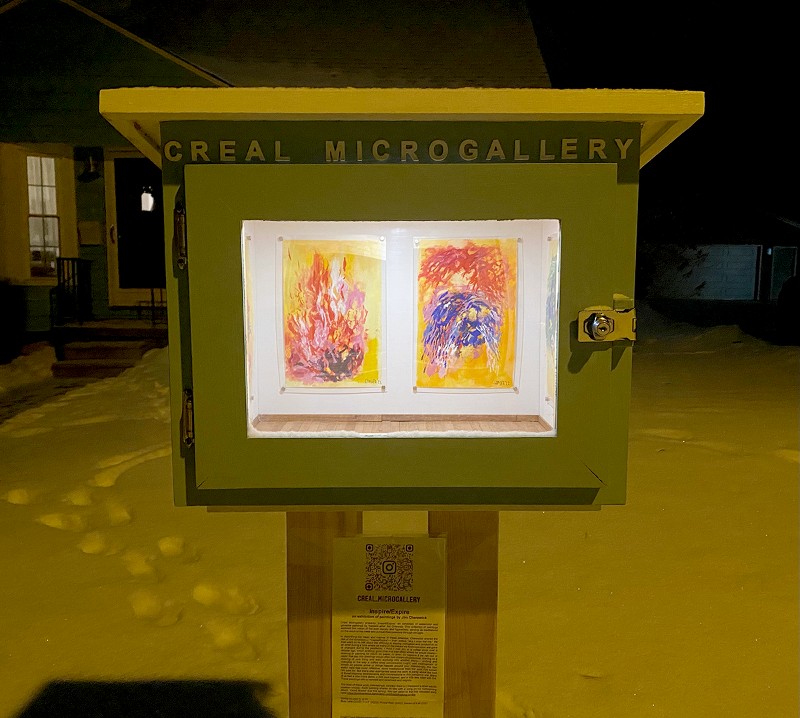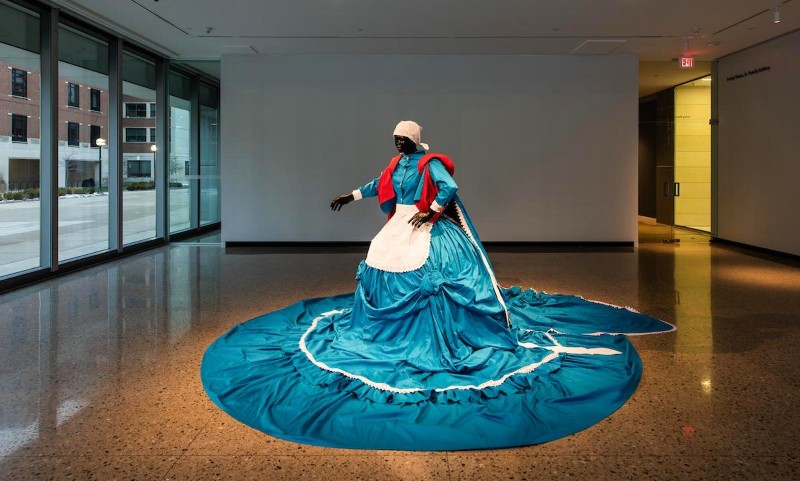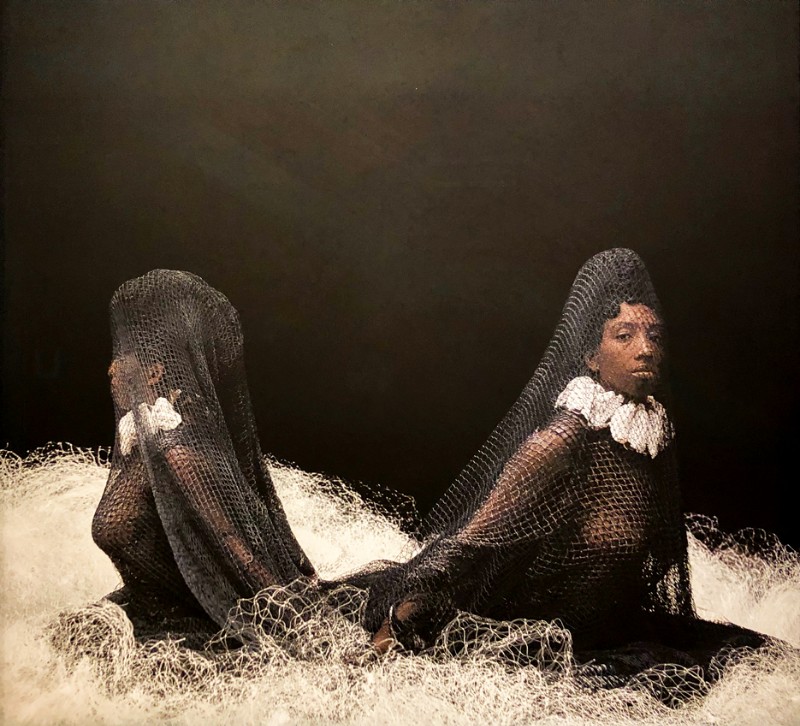From Marsalis to Schubert: The Philadelphia Orchestra spent two evenings serenading Hill Auditorium with contrasting programs and conductors

When Yannick Nézet-Séguin sprang onto the stage last Friday night at a packed Hill Auditorium, he was seemingly filled to the brim with energy. Though the Quebecois conductor and pianist is nearing 50, last weekend his every movement in front of the Philadelphia Orchestra seemed to be infused with a kind of youthful exuberance, from his stretch across the conductor’s podium to shake concertmaster David Kim’s hand prior to the performance, to the athletic exertions he subsequently made during the most bombastic moments of the evening’s program.
U-M's Basement Arts theater troupe used "The Visit" to explore the dangers of group-think

It doesn’t take a genius—or a grand performance on stage—to reveal how people will do anything for money.
On February 25 and 26, Basement Arts, a U-M student theater organization, gathered at the Newman Studio in the Walgreen Drama Center and performed Friedrich Dürrenmatt's The Visit, which shows how far people will go.
First published in 1956, The Visit tells the tale of millionaire Claire Zachanassian who returns to Güllen, the small town where she grew up. Excited by her visit, the townspeople decide to take this opportunity to better their town and their lives as they’ve fallen on hard times. But Zachanassian has a different plan in mind: In exchange for a one billion dollar donation to Güllen, she wants the townspeople to kill Alfred, the man who she became pregnant with, then jilted her.
Ann Arbor's Creal Microgallery offers tiny exhibitions for unsuspecting pedestrians

The first reaction a pedestrian might have upon encountering the Creal Microgallery in suburban Ann Arbor might be amusement. This tiny, breadbox-sized art space on Creal Crescent, not far from the North Maple Road and Miller Avenue intersection, resembles one of those little free libraries often found on residential streets. It provides curbside delivery of fine art to passers-by from dawn to 11 pm daily. This may not be a grand structure like the elegant Stettheimer dollhouse in the Museum of the City of New York, with its tiny masterpieces by Alexander Archipenko, Gaston Lachaise, and Marcel Duchamp, but it’s no joke either.
The microgallery’s founder and curator, Joe Levickas, was inspired to start the project by dislocations in his life during the COVID-19 pandemic. He describes bringing up his idea for the gallery with his wife. “What if we put up a gallery in our front yard?” A real team player, she replied, “You should totally do it.” He acquired a 16”x10”x12” box with a glass front, painted it robin’s egg blue to match his house, and the rest is (art) history.
Singer-songwriter Allison Russell brought her "Outside Child" and open book to The Ark

Singer-songwriter Allison Russell seeks out what she calls the “hidden canon” of the oral tradition: the songs, stories, lore passed on through time, primarily from and for women. Ann Arbor's The Ark is one of those places where the hidden canon has been voiced frequently for a very long time, and Russell’s concert there on February 25 felt like the perfect place to carry on that tradition.
Musical theater met Kahil El’Zabar & Co.'s jazz in perfect harmony at Encore

The “great American songbook” and jazz have always had a strong relationship. Popular songs have been an important source for jazz improvisation from the very beginning and jazz has influenced popular music composers to adapt dynamic rhythms, blue notes, and the uptempo style of the emerging jazz players of the 1920s.
The Encore Theater is celebrating Black heritage with an exciting pair of musical reviews this month. On February 18, a program called Modern Jazz Meets Musical Theater made a strong case that the popular music of the golden age from the 1920s to the 1950s was a collaboration of a diverse group of performers and composers that is still rich and vibrant today. Many of those who created the American Songbook were first-generation immigrants from Europe and Black Americans who found a common voice.
The man making that case is, as the Encore program says, the legendary Kahil El’Zabar, an inspired percussionist, driving band leader, and wise teacher. El‘Zabar and his Ethnic Heritage Ensemble joined forces with four superb singers to give us a sampling of show tunes, blues, and pop standards in a smokey setting on the Encore stage. Each song segued from vocalist and band to rich, lively, thought-provoking jazz improvisations on the music and then rounded back to the singers.
U-M's modern-leaning production of "Antigone" explores grief in the pandemic age
Sam White, founder of Shakespere in Detroit, guest directed the University of Michigan’s School of Music, Theatre, and Dance’s recent production of Antigone (February 17-20). She felt the weight of the pandemic while conceiving of the staging and decided that rather than putting on a play written in 441 BCE as some sort of separate escapism from our current world, the two can interact and help one another.
Because the "Layl" belongs to lovers in choreographer Ali Chahrour's musical play

The curtains opened and revealed a dark stage. It was silent, and over the course of a few minutes, lights started to show the audience fragments of what was on stage while keeping the illumination dim enough that you had to squint to see there were people with instruments tucked in the left corner of the stage.
Eventually, the light, though still low, revealed everyone on stage: Sharif Sehnaou on guitar, Hala Omran with a microphone, Aya Metwalli with a guitar, Simona Abdallah on drums, and above them all, Ali Chahrour lay on top of the speakers, one arm dangling and the other with a bouquet of dead flowers in his hand.
This is the entry to Layl (Night) by Ali Chahrour, presented at the Power Center in Ann Arbor on February 12.
Mary Sibande's "Sophie/Elsie" sculpture anchors UMMA's African art gallery

Sophie/Elsie is a striking sculptural figure, vibrant and visible from a distance, a colorful, bright beacon in the newly expanded and reopened African galleries at the University of Michigan Museum of Art.
Johannesburg-based artist Mary Sibande’s fiberglass sculpture, created in 2009, and initially on display during UMMA’s closure, is now permanently installed. In the early days of the museum’s closure, Sophie/Elsie was visible from outside the galleries—then, construction came, and she was no longer visible from outside.
But Sophie/Elsie is once again on display in the reimagined space of UMMA’s African galleries. Along with works by Jon Onye Lockard, Shani Peters, Jacob Lawrence, and many more, Sibande’s sculpture brings new life to the gallery space as part of the ongoing initiative We Write to You About Africa, in which “contemporary African artists, scholars, and curators will be asked to write about their work on postcards, in their first language, and mail them to UMMA where they will be displayed alongside their works.”
The reinstallation—including a gallery extension—is now open to visitors in the Robert and Lillian Montalto Bohlen Gallery of African art and Alfred A Taubman Gallery II.
Ann Arbor Gallery Crawl: Catching up with recent exhibits and new art spaces

Double Goddess: A Sighting in the Abyss by Ayana V. Jackson at A2AC Gallery. Photo by K.A. Letts.
COVID-19 has wrecked plans and canceled events for nearly two years (and counting). It has sabotaged the momentum and slashed the incomes of Ann Arbor’s small community of visual artists and galleries, leaving a cultural landscape greatly altered in ways large and small.
But the creatives here are nothing if not resourceful and, well, creative.
My recent tour of the art spaces and non-profits in Ann Arbor and environs left me encouraged—and impressed—by the resilience of the city’s art community. Here are some of the changes I came across while reintroducing myself to the local art scene in early December 2021:
Stamps Gallery's "Envision: The Michigan Artist Initiative" celebrates creators who are inspiring the next generation
Based on my direction of approach to the University of Michigan's Stamps Gallery, I didn’t see Michael Dixon’s large-scale sculptural alligator head with one sharp, gold tooth before entering—though it's visible in the gallery’s large front windows.
Inside the sculpture’s large open jaw, children’s toys rest as if inside a toy box. Among them, a selection of brightly colored balls, dolls, and books we might recognize from a modern store, but also amidst the display are racist toys such as a mammy doll, which remind viewers that these harmful toys are still collected and sold, holding a space in contemporary American culture that often escapes criticism.
This idea is further enforced by the inclusion of problematic Dr. Suess books, which became a topic of national conversation this past March.
Dixon is among five artists represented in Envision: The Michigan Artist Initiative, a new program focused on promoting the careers of Michigan-based artists.
This awards initiative “recognizes the creativity, rigor, and innovation of Michigan-based artists and collaboratives—and honors their role in inspiring the next generations of artists in our state.”



































